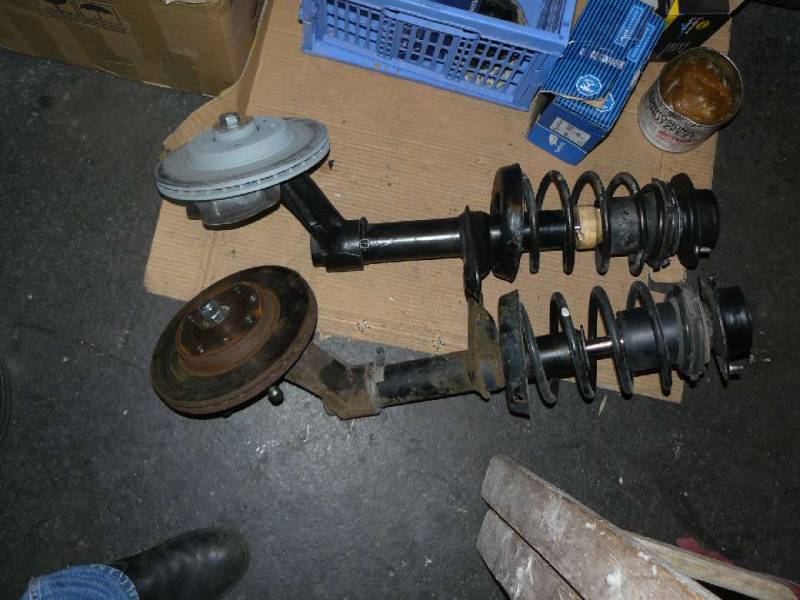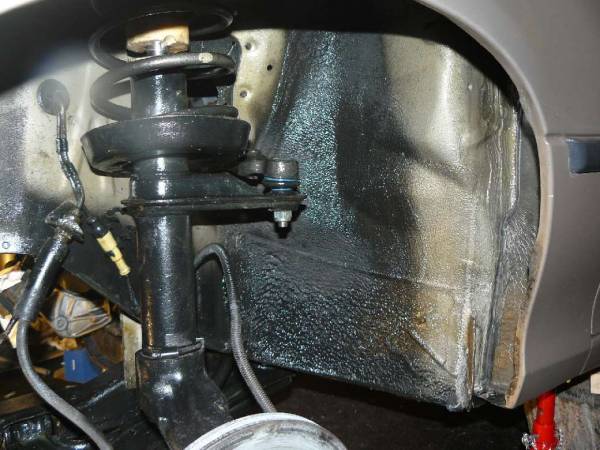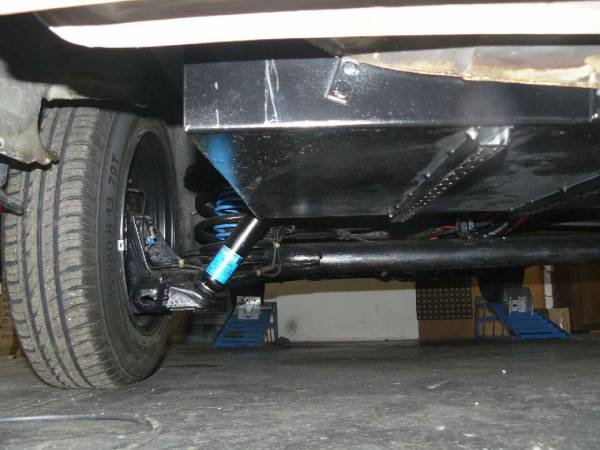User Tools
Sidebar
Table of Contents
rust prevention
A good part of the restoration and repair work is about removing rust and preventing new corrosion.
A little preview to chapter "front axle": Suspension struts - before and after.
issues around painting
The acrylic spray paint I have been using to make the overhauled parts look nice admittedly is not an efficient protection against rust. It gives rather thin layers, is too soft and does not stick well to the surface. So, rust can undercut it easily. In addition, if a part has been rusted and the rust was removed using a grinder, there will always be particles of rust left in pores of the material, or even “rubbed into” the material by the grinder.
A more promising approach of making things rust-free is to clean them by sand-blasting. This gives a clean surface, which is also rough so that paint will hold much better. Instead of acrylic paint, two-component primer (or primer that hardens by chemical reaction with water vapor, such as POR15) will provide a coating of sufficient thickness and good mechanical resistibility.
Unfortunately, for efficient sand-blasting and spray-painting with good paint, the parts need to be completely disassembled. Probably you will lack the required facilities, so you need to bring everything to a specialist. The car body, for such a treatment, will have to be freed from most attached parts and also be brought in. So, a lot of parts need to be disassembled at the same time - but if you are not so experienced or for practical reasons, you will rather want to rework one part after the other.
And anyhow, such effort would also rather fit to the restoration of a valuable oldtimer - but not to a mid-class “everyday's” car.
Finally, even this high-end treatment of complete disassembly, sand-blasting and painting with good primer will not sustainably protect against the rust still lurking between overlaps and in seams.
Richard's strategy
So I have followed different approaches against rust:
new steel parts
On new steel parts, such as battery boxes and auxiliary frames, I have indeed mostly invested the effort of having them “professionally” treated as described above.
corroded steel parts
For parts that had already been corroded, my “strategy” against rust however is:
if not visible
..i.e. everywhere except on “visible” surfaces that have to look nice:
* First, remove existing rust: A thin layer of “base” rust may even remain. In this project, I have usually removed rust with a wire brush on an angle grinder.
* Do not paint, or only in “cosmetic” layers.
* Cover with anti-corrosion grease (e.g. Mike Sander's ), especially on seams and on surfaces that had been rusty. The grease can be heated with a hot air blower so that it already spreads and soaks in. Alternatively, you can apply it “cold” and rely that it will spread the next hot day. Just grab a lump of it with a rubber glove and smear it onto the parts that you want to protect. Haptically exploring the curves of your car's body is a sensual experience for both of you and you won't want to miss it. Besides, you can achieve thicker layers and you will reach (and be able to check for loose rust) also areas that are concealed to the eye.
Protective wax is not helpful, if directly applied to surfaces that have already been corroded. Although it deceptively looks as if it were, as long as it is fresh. Anti-corrosion grease performs much better, because it keeps “creeping” and keeps soaking the rust for years. The grease itself however may be covered with wax (e.g. PermaFilm) as a second layer. The wax “finish” looks better and avoids that the grease washes off from exposed areas.
This picture shows parts soaked with anti-corrosion grease:
Here (picture borrowed from the “rear axle” chapter), the rear axle has been coated with PermaFilm wax on top of the grease. The battery box that you see in the front, as a new part, has been sand-blasted and coated with primer.
If the car is also operated during winter, is a good practice to once every year wash the winter's salt off, to check everything and redo above steps where necessary.
One just has to accept that an old car is not “maintenance-free” …
if visible
.. i.e. visible areas of the car body, that must become nice and shiny
In case of rust on the car body, my approach (the “chemical” part of it being highly inspired from the POR15 products and instructions) is:
* grind down the rust completely
* in case, weld up the holes and grind the welds flat
* wash off traces of grease
* apply rust converter, that chemically converts remaining rust into gold (for the guy who sells it to you). The effect of rust conversion may be debatable, since even with patience, only the very surface of the rust will actually get converted. Some rust converters however also etch the surface of the metal, so that it gets rough and holds the paint better.
* wash off the remains of the rust converter (this is important!)
* apply a good primer (as said above - a two component primer or one that hardens by chemical reaction with water).
* filler and paint job - this is really “high art”, so one better leaves it to a professional.




